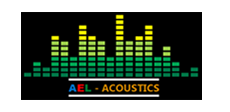Acoustics – The study of all mechanical waves, including vibration, sound, ultrasound, and infrasound.
Airborne Noise – Airborne noise is any sound that is transmitted through air.
Attenuation – Attenuation is the gradual loss of intensity through a medium. When discussing acoustics, attenuation refers to a structure’s ability to limit sound transmission.
Baffle – an acoustic baffle is a device that reduces the strength of airborne sound. Audimute’s Acoustic Baffles are designed to suspend vertically from ceilings. When used effectively in a space, Acoustic Baffles will help to absorb sound, reducing echo and lowering reverberation time.
Cloud – Similar to acoustic baffles, acoustic clouds are free-hanging absorption panels that are suspended from a ceiling. However, acoustic clouds are designed to suspend horizontally.
Decibel – A unit of measurement used to describe how loud something is.
Echo – An echo is created when reflected sound reaches a listener’s ear with a delay after the initial creation of sound. Echo is one of the most common acoustic problems. Echo can be exacerbated by hard surfaces or large, open spaces.
Flanking Sound – Sound that travels between two spaces indirectly. This can be sound that’s traveling through vents to reach another room, for example.
Flutter Echo – Flutter echo is an echo that occurs when sound is reflected off parallel surfaces, but reaches the listener at different times, creating a fluttering sound.
Footfall – Footfall is a form of impact noise that is created by walking. Footfall occurs when feet come in contact with a floor. This can be a common issue in many multi-floor apartment complexes.
Frequency – When discussing sound waves, frequency is the number of waves that occur in a selected period of time. In terms of sound, frequency generally correlates to the pitch of a sound. Low frequency sounds tend to be much lower in pitch than high frequency sounds.
IIC (Impact Isolation Class) Rating – IIC ratings measure a structure’s ability to limit impact noise and vibration transfer. Similar to STC, the higher an IIC rating, the better a structure is at limiting impact noise and vibration. An IIC of above 50 is required in many commercial spaces to limit footfall and impact noise.
Impact Noise – impact noise is a structure-borne sound that is created when two objects come in contact. The impact of these two objects will create a structural vibration, which can travel through walls, floors, ceilings, doors, and windows.
NRC (Noise Reduction Coefficient) Rating – NRC Rating roughly translates to the amount of sound absorbed by an item. NRC ratings typically range between 0 and 1, with 0 being perfectly reflective, and 1 being perfectly absorptive. The formula used to determine NRC does not provide a percentage, however, so values can be greater than 1.
NRC ratings roughly translate to the percentage of sound absorbed by an item. For example, a product with an NRC rating of 0.95 (such as our 1.5” thick AcoustiColor Tiles) would absorb roughly 95% of the sound it comes in contact with. NRC ratings measure frequencies ranging between 250 – 2,000 Hz.
Reverberation – Reverberation is the persistence of a sound following its initial creation. Reverberation is created as sound reflects off surfaces and decays. Reverberation can be particularly bothersome when the initial source of sound stops, but the sound continues to reflect and decay.
Reverberation Time – a measure, in seconds, of the time it takes for a sound to decay entirely. For smaller rooms, reverberation time should typically be under a second, while larger rooms, such as auditoriums, should typically have a reverberation time close to 2 seconds.
Sound Absorption – The process by which sound waves are taken in (or absorbed) by an item or structure, rather than being reflected off the item.
Sound Barrier – A material that can be placed on a structure (such as a wall, ceiling, or floor) that will increase the STC rating of the structure.
Sound Pressure – The pressure created in a space in the presence of sound.
Soundproofing – Soundproofing is the process of reducing sound pressure within a space.
STC (Sound Transmission Class) Rating – STC Rating is a numerical value representing how well a structure is at reducing airborne sound transmission. STC is commonly used to rate walls, doors, windows, ceilings, and floors. For STC ratings, the higher the value, the better a structure is at reducing airborne sound. A well soundproofed wall typically has an STC rating above 50.

















